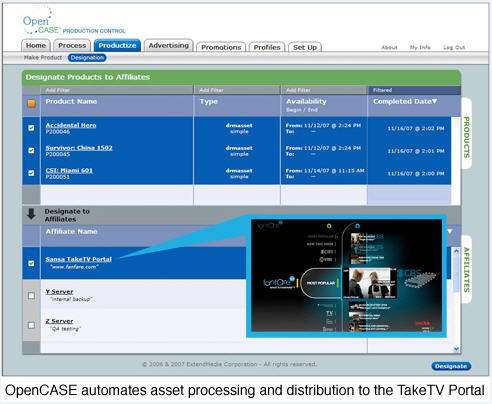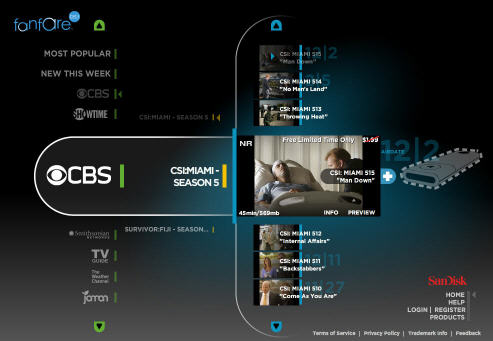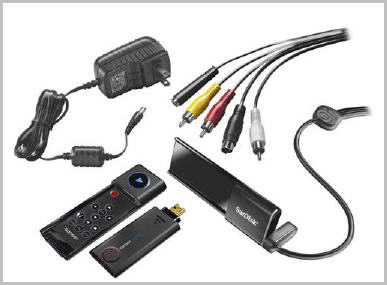-
Understanding TakeTV/Fanfare's Demise
Late last week came news that SanDisk has discontinued its TakeTV device and companion Fanfare content aggregation web site, which were unveiled last October. TakeTV was an inexpensive USB PC-TV connector that allowed users to grab video from Fanfare, for easy playback on their TVs.
I gave TakeTV and Fanfare a moderately positive review and thought that as a low-end product it could gain some traction. I thought of it as having "stocking stuffer" appeal - a relatively cheap gadget that would find its market. I've done a little asking around to try to understand what happened.
From what I've gathered, it sounds like SanDisk ultimately recognized the reality that TakeTV was really
 peripheral to their core focus of marketing memory products. Too much customer education would be required to move this product, especially in the face of quasi-competitors like AppleTV, Vudu, Xbox and others. In addition, minimums from Hollywood to gain top-notch content has continued to raise the bar for startup devices like these to succeed.
peripheral to their core focus of marketing memory products. Too much customer education would be required to move this product, especially in the face of quasi-competitors like AppleTV, Vudu, Xbox and others. In addition, minimums from Hollywood to gain top-notch content has continued to raise the bar for startup devices like these to succeed. Yet, my bet is that we haven't seen the last of SanDisk's involvement in the broadband video market. Like hard-drives, processors and PCs themselves, memory products rely on ever-larger applications to drive the consumer purchase cycle. For SanDisk, video has to be right at the top of their list in terms of the apps that will create demand for its increasingly capacious storage products. So stay on the lookout for SanDisk to resurface somewhere in the video landscape.
Categories: Devices, Technology
Topics: SanDisk
-
ExtendMedia Powers SanDisk Broadband Video Initiatives
I recently caught up with Keith Kocho, founder of ExtendMedia to discuss how Extend is supporting SanDisk's recently announced Sansa TakeTV player and companion Fanfare application. In a recent review, I was impressed with SanDisk's approach, which is somewhat akin to the iPod-iTunes pairing. Extend (disclaimer, a VideoNuze sponsor) is playing a key behind-the-scenes role, which will become especially important as FanFare transitions from its current trial model to a hybrid ad-supported and paid download approach.

Keith explained that Extend's OpenCASE product is providing the ability for SanDisk to manage Fanfare's content catalog, create the business rules for each piece of content and deliver encryption depending on the rules. OpenCASE also allows SanDisk to bake ads into the video file as its currently doing, or dynamically insert them as SanDisk intends to do in the next phase.
The screen grab below illustrates how a piece of content uploaded to OpenCASE can be delivered into Fanfare with appropriate rules.

Kate Purmal, SanDisk's SVP/GM for Digital Content offered this perspective, "OpenCASE is seamless and flexible and has proven to be truly 'plug and play; with our encryption and DRM software with Extend's business rules layered on top. As we expand into our next phase with more content and commerce options, OpenCASE is going to be able to easily scale up with Fanfare."
I think Kate's latter point hits the nail on the head: in the future, for any of these digital video stores to succeed - whether they are tied to a device, as Take TV is to Fanfare, or they aren't - the digital video stores of the future are going to all offer hybrid approaches for consumer to access content.
The concept of an iTunes, which only offers an a la carte purchase/download model is going to quickly become antiquated. Instead consumers will be offered choices including a la carte downloads, ad-supported downloads, ad-supported streaming, ad-supported and paid subscriptions and more. This is one of the hallmarks of broadband - that it offers content providers and aggregators unlimited monetization flexibility depending on the circumstances and rights. As such, I think that platforms such as OpenCASE and others that can support flexible models are going to become increasingly valuable.
Categories: Devices, Technology
Topics: ExtendMedia, SanDisk
-
Sansa TakeTV + Fanfare Should Have Stocking Stuffer Appeal
Today SanDisk officially announced its "Sansa TakeTV' USB PC to TV device, which is married to its "Fanfare" digital download store. As "convergence devices" go, this is about as straightforward as it gets. Fanfare is still pretty lean on content, but that will no doubt change quickly.

I saw an early version of this product at the NAB Futures Summit last April (CNET's Brian Cooley brought one along) and for simplicity it's hard to beat. You download the Fanfare software (a snap), plug the device into your USB, download files, and then plug the device into its cradle, which is connected to your TV. What I haven't seen is the UI for the TV, so I can't comment on that.
Considering I witnessed my 8 year-old nephew figure out how to plug his digital camera into his TV to do slide shows, I'd expect Sansa TakeTV to appeal to a pretty wide audience of non-techies. And at $100 for the 4GB model (saves about 5 hours of video), it's a solid "stocking stuffer" for the upcoming holiday season.
Sansa TakeTV is another example of the limitless innovation underway to converge the PC/broadband video world with the TV world. To date most of the solutions here (except AppleTV and Xbox probably) have been pretty techie, requiring some degree of user intervention to marry the PC and the TV over the home wireless or wired network. It's safe to say that none of these devices has yet caught on.
Sansa TakeTV's issue is whether it can be anything more than a short term, low end solution. A lot of the answer is wrapped up whether USB Flash storage can scale up to inexpensively handle lots of video. For example, the low-end AppleTV holds 40 GB and costs $299, while the 16GB USB Flash drives I found online approach $200 alone, never mind the software and other component costs in the Sansa Take TV package. (see below).

However, if anyone's going to figure out how to make USB Flash storage competitive for video, it'll be SanDisk. In the meantime, there's nothing wrong with accepting Sansa Take TV for what it is - an easy-to-use, low end product for the masses to watch high-quality broadband video on their TVs.
Categories: Devices
Topics: Apple, AppleTV, SanDisk, TakeTV
Posts for 'SanDisk'
|


